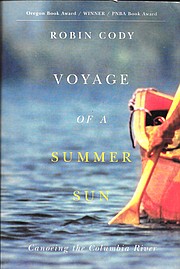Book review and other things
Dennis L. Clay Herald Columnist | Hagadone News Network | UPDATED 8 years, 1 month AGO
Karen Crook called a couple of months ago.
“I’ve just finished reading a book and thought of you might enjoy it also,” she said.
Now it is in my hands and has been read from beginning to end. The book: “Voyage of a Summer Sun, Canoeing the Columbia River,” by Robin Cody, Oregon State University Press.
Cody began his journey of canoeing all, or as much as possible, of the Columbia River in June of 1990. This began near Canal Flats, British Columbia, 220 miles north of Spokane.
“I reached the spot in flat snow and ice where the stream stopped. Or began. Percolating as Springwater from the earth at my feet was the baby Columbia River, flowing north.”
This was in the area of the Columbia where a person can stand with one leg on both sides of the river. Indeed, it flows north, before making a U-turn and heads south. Cody expected the trip to last three months, because factors such as wind, river current and other weather conditions played a part in the time involved.
The author gives the history of the areas he passes along the tour. At Vantage, he lives up to a promise he made to his sister to visit with her friends. He does so and spent a couple of days at the Verheys’ Orchard. This is one of the few instances where he takes time out of the trip for a visit.
Cody rides the locks on the dams, even in his canoe, when it is practicable. He holds up when the river rough and not safe. He camps in a tent, but stays in a motel or other lodging when near a village or town.
His adventure ends on September 3, near Tongue Point. He waits for the incoming tide to change, then catches the outgoing tide and paddled hard to make the West Boat Basin, before the river carries the canoe into the big waves at the mouth.
This a great book for readers who enjoy an unusual adventure. Think about this: It would be a great time to travel the entire Columbia River on a larger boat and camping in a large tent, using a large cooking stove, but Cody does it all in a canoe, using a small tent and stove. What an adventure.
Shooting sticks
My recently-made shooting sticks were a great help on this year’s deer hunt. However, they weren’t used when shooting my deer. They were used as a walking stick only.
It required a fair amount of time to make them. Several columns or parts of columns were written describing the process. This was a fun and rather entertaining experiment.
The sticks suffered a few blemishes during the hunt. The black paint on the rubber cane tips became chipped from encountering rocks. The black paint on the wood suffered scratches from bumping into sagebrush and other objects.
All of these marks and imperfections can be corrected with another coat of black paint. But they will be removed from my hunting equipment and used just for hiking.
One of my hunting buddies had a new Primos Trigger Stick with two legs, a bipod, and another had a Primos Trigger Stick with three legs, a tripod. While I needed to stop and spread the two sticks apart as a shooting platform, all they did was pull a trigger and the legs dropped to the proper length. This device also acts as a walking stick.
I’m planning to obtain a Primos tripod before next hunting season.
Cleaning the Excalibur Meat tenderizer and Jerky Slicer
Recently an article about butchering deer appeared in this space. Part of this column explained the use of the Excalibur Meat Tenderizer and Jerky Slicer.
This hand-cranked machine uses two sets of two blades, one set for cubing steaks and the other for slicing pieces of meat into slices for making jerky. This is an excellent tool for both objectives.
The tenderizer sends knives through the meat to tenderize the meat. The steak will become a cubed steak if the steak is turned 90 degrees and passed through the device again.
The old way of making jerky slices is to slice the meat by hand. Enter this slicer, where one turn of the handle reduces a hunk of meat into slices for jerky in one pass. It is now prudent to spend a few minutes talking about cleaning the machine.
These knives are sharp, so care must be taken. A brush with long plastic bristles are used at first to remove meat residue. Then an old steak knife is used to pick out any leftover pieces. The rest of the machine is cleaned easily with a sponge.
Of course, this cleaning takes place in warm-soapy water, with a rinse in hot water. The various pieces are allowed to air dry.
ARTICLES BY DENNIS L. CLAY HERALD COLUMNIST

Flash floods reported in 1979
E-mail from Cheryl

SHOT Show full of information
Many hunters have heard of the SHOT Show, but few have attended. SHOT stands for Shooting Hunting and Outdoor Trade Show.

How to prepare and cook a wild turkey
Two tagged turkeys were in back of the Ram, now what? My wild turkeys are skinned after a successful hunting trip. This year the procedure was changed a bit.



